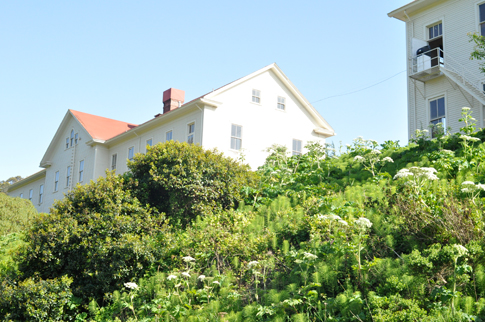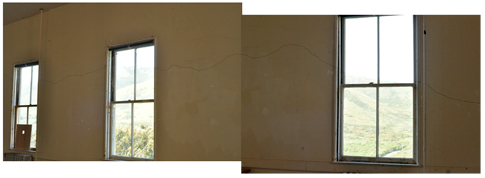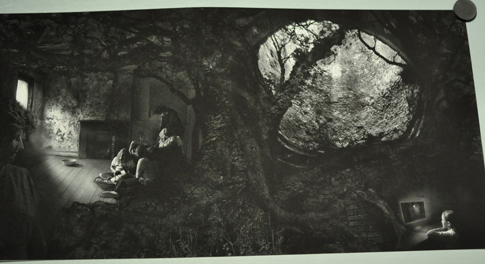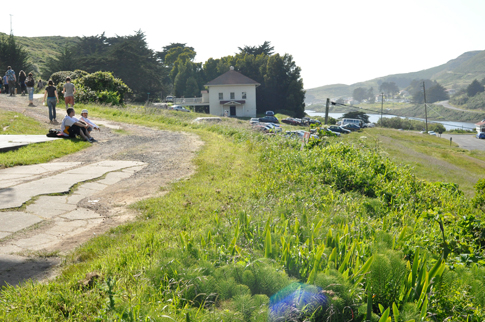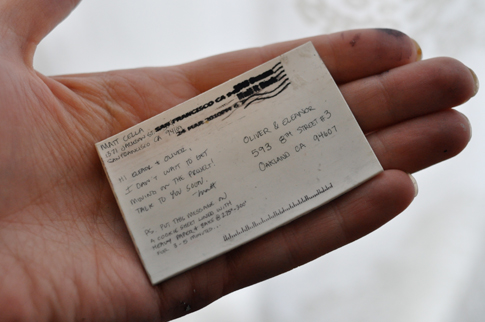Archive for 2010
2 x 15K for Public Art in the Bay Area: Southern Exposure Offers a New Award
artist resources arts funding bay area blog

For two years, Southern Exposure, enabled by the Graue Family Foundation, is going to offer a 15K award for Public Art Projects in the Bay Area. Artists nationally and internationally are encouraged to apply. It is really wonderful to see some significant awards coming out of the Bay Area.
The Graue Award is an initiative of SoEx Off-Site, a program of Southern Exposure’s founded in 2006 that seeks to commission and present new public work by emerging artists that intervenes and interacts in the social and political spheres beyond the space of gallery. SoEx supports and encourages these practices as few venues support emerging artists working in the public. The artists selected through the program will make a proposal and develop their work in relation the San Francisco Bay Area.
It is an Open Call! Applications for the 2011 project are due May 26th, 2010.
Details Here.
Somebody wrote about us!
arts funding bay area collecting resources good things news subscription art
We’re honored to be included in this roundup by Emilie Raguso of Oakland Local of Art Subscriptions in the Bay Area. There’s starting to be quite a number of us! It is really wonderful how this idea is spreading, and people are making it their own. Thanks to Emilie and Oakland Local, and Welcome to any new visitors!
Edible City" class='title'>Edible City
In-Flight Food Tries to Be Tasty" class='title'>In-Flight Food Tries to Be Tasty
B-UNCUT Talks With SFMoMA’s John Zarobell" class='title'>B-UNCUT Talks With SFMoMA’s John Zarobell
The Bullshit Artists" class='title'>The Bullshit Artists
art world blog contemporary art criticism
Top 10 Sites for Designers" class='title'>Top 10 Sites for Designers
art meets design artist resources
Value of Art: Sea Ranch Chapel Edition
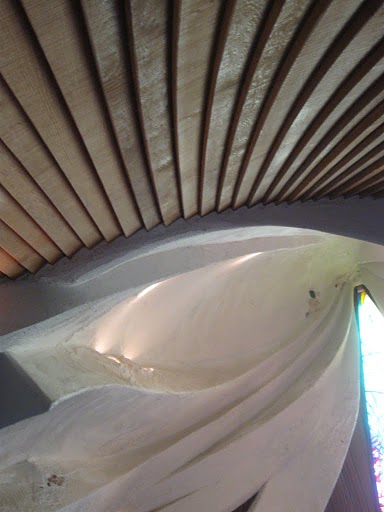
From the Brochure (my italics):
The Sea Ranch Chapel is a gift of two Sea Ranch residents who wished to offer a nondenominational sanctuary for prayer, meditation, and spiritual renewal. It was their hope that all who enter will find a measure of peace in the blending of art and purpose amid surroundings of beauty and inspiration.
The chapel is dedicated to the memory of a young man, navy aviator, artist, and zoologist, who believed that art is the intermediary between the physical and the spiritual.
$200,000 awarded to 26 Califonia Artists: CCI announces it’s Round 5 “Investing in Artists” Grantees.
arts funding bay area blog news
Congratulations to all!
“We know that grants to individual artists are an important means to help them advance their work, and this is particularly true during an economic recession when financial resources are so scarce,” said CCI President and CEO Cora Mirikitani.
Round V of the Center for Cultural Innovation‘s Investing in Artists grants program specifically provided support to working artists in the Visual Arts, Craft and Literary Arts in two categories: 1) for the acquisition of Artistic Equipment & Tools; and 2) for Artistic Innovation.
In the Artistic Equipment & Tools category, fourteen (14) artists received Investing in Artists grants:
· Susan Avila (Craft, Oakland)
· Amy Balkin (Multidisciplinary, San Francisco)
· Chris Bell (Multidisciplinary, San Mateo)
· Cindy Bernard (Visual Arts, Los Angeles)
· James Buckhouse (Multidisciplinary, Palo Alto)
· Heather Bursch (Visual Arts, Los Angeles)
· Joshua Churchill (Multidisciplinary, San Francisco)
· Binh Danh (Photography, San Jose)
· David Gurman (Multidisciplinary, San Francisco)
· Taro Hattori (Visual Arts, Oakland)
· Packard Jennings (Multidisciplinary, Oakland)
· Larry Kline (Visual Arts, Escondido)
· Blaine Merker (Multidisciplinary, San Francisco)
· Kim Stringfellow (Multidisciplinary, Joshua Tree)
In the Artistic Innovation category, twelve (12) artists received Investing in Artists grants:
· Jeff Chang (Literary Arts, Berkeley)
· Sara Daleiden (Multidisciplinary, Los Angeles)
· Sergio de la Torre (Multidisciplinary, San Francisco)
· Amy Franceschini (Visual Arts, San Francisco)
· Guillermo Gomez-Pena (Multidisciplinary, San Francisco)
· Desiree Holman (Multidisciplinary, Oakland)
· Ali Liebegott (Literary Arts, San Francisco)
· Kelly Nipper (Multidisciplinary, Los Angeles)
· Scott Oliver (Visual Arts, Oakland)
· Alison Pebworth (Visual Arts, San Francisco)
· Jessica Rath (Visual Arts, Los Angeles)
· Philip Ross (Multidisciplinary, San Francisco)
Discussion: CMC Information Initiative
Please use the comments to contribute your thoughts about the project.
Here’s what we’ve been thinking about:
Artist Ingrid Burrington’s work as the CMC does more than offer us a glimpse of urban solitude. It also highlights our increasing reliance on statistics. The fieldbook plays off of our familiarity with these types of studies. Whether it’s justifying a political cause or helping to sell a product, the pie chart and line graph have become ubiquitous. In our frenzied lives a catchy graph can be a stand-in for certainty: instant truth. These scientific tropes lend the same sort of weight and authority that Ingrid enjoys by making work under the guise of a think-tank. As the volume of data about the minutia of our lives grows exponentially and it becomes easier to make a case for any particular point of view, what will happen to our faith in numbers?
Along this theme, I just found this article by Rebar over at the SFMOMA blog all about infographics.. Here’s a choice snippet from the article:
Of course this is the point. We’re so awash in data that we cannot make decisions. We have access to enough GIS layers to drown a graduate program without ever giving us a useful conclusion. Just the act of making a simple infographic today is an acknowledgment of this predicament, an ironic avoidance of the databloat of our bullying zeitgeist. The “subjective” infographic is a guilty pleasure: we know it doesn’t represent reality any more than the Harper’s Index represents a statistical analysis. Because we can all enjoy it, it’s not quite masturbation; it’s more like really well-done porn.
Annotated Links: Center for Missed Connections Information Initiative: Artists working with missed connections and acting as think tanks
Ingrid’s Links:
http://www.subwaycrush.com/ -Public transit specific Missed Connections site
http://www.theworkoffice.com/ -This was an artist team’s project that gave me the first opportunity to explore Missed Connections research, and has been certainly influential in the development of the CMC.
Missed Connections as inspiration for Artwork:
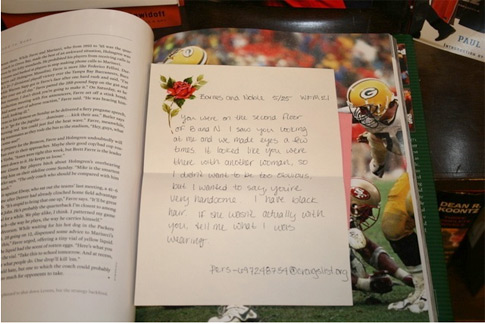 Missed Connection Intervention: Barnes and Noble 2 of 3, 2008
Missed Connection Intervention: Barnes and Noble 2 of 3, 2008
Craigslist Missed Connection ad taken from online and written on letters that where slipped randomly into books.
Paul Short’s Missed Connection Interventions. He goes back to the places of the missed connection and inserts the message in place.
I Saw You.. A Comic Book Anthology of comics by over 100 artists with the subject of missed connections.
Missed Connections Live: A video web series by actress Melissa Center and produced by LBM Productions. Each episode is centered around one Missed Connection post. They act out both the actual missed connection post and sometimes the aftermath.
Sophie Blackall: a New York Illustrator working with Missed Connections

Greenpoint Laundromat, Sophie Blackall. 2010 Prints available on etsy
Cartoonist Adrian Tomine has his own take on Missed Connections, produced through OMG Posters!
A Musical: http://www.newhavenadvocate.com/article.cfm?aid=16665
Steve Lambert interviews a variety of people who have used Missed Connections
“Status Update”: a show of art that has come out of social networking. Curated by Debbie Hesse with the support the Arts Council of Greater New Haven, the show was displayed at Haskins Laboratories, a private nonprofit group affiliated with Yale and the University of Connecticut that specializes in communication: mainly speech, language and reading research.
Artists as Think Tanks, Organizations, and Companies:
Dominic Willsdon describes an unrealized project by Jon Rubin to create “The Bastard Academy” a mock think-tank intended to be built on the Standford campus between the art department and the Hoover Institute. Courtesy of the Anecdote Archive.
Interview with Jeannene Przyblyski, founder of The San Francisco Bureau of Urban Secrets.
The Ghana Think Tank: In 2006, John Ewing, Christopher Robbins and Matey Odonkor formed the Ghana Think Tank in response to their experiences working in international development. We sent a set of US community development briefs to ad-hoc think tanks formed in Ghana, Cuba and El Salvador. The problems addressed in these briefs ranged from broad, societal issues (Homelessness and Obesity) to more personal, light-hearted quandaries (Bo Can’t Dance and Powerpoint). After receiving the think tanks’ solutions, we set about formulating specific plans of actions based on these responses, and began to enact them.
Death and Taxes: a year-long performance project by Isabel Reichert and Sean Fletcher involving a subchapter S-Corporation called Death & Taxes, Inc. This corporation, run by a professional board of directors, took charge of our family’s personal finances in an effort to make our artist lives more profitable. In essence, they privatized their lives.
#class: Jenifer Dalton and William Powhida turn Edward Winkleman Gallery into a ‘think tank’, where they will work with guest artists, critics, academics, dealers, collectors and anyone else who would like to participate to examine the way art is made and seen in our culture and to identify and propose alternatives and/or reforms to the current market system.
The Center For Missed Connections: Charting Loneliness and Social Irrealities
blog CMC contemporary art criticism TPG13
If you live in a city, or even if you don’t, you have likely heard of and/or utilized Craigslist. From its humble beginnings, the website has grown to international proportions; used to place ads for jobs, housing, and those looking for human contact. Perhaps the most compelling aspect of the site is its category Missed Connections (MCs). Here, people post anything from one line to many paragraphs; seeking out those whose path they’ve crossed, people they’ve lost contact with, strangers they’ve seen in bars or cafes or streets that caught their attention. These posts reflect a desire to try and make real contact, when so much of our lives are spent surrounded by strangers, hours at work, or online. In the past year alone, these anonymous listings have inspired a book deal, blogs dedicated to the best of MCs, and artists’ work. Baltimore-based artist Ingrid Burrington has created a piece utilizing Missed Connections that is at once tongue-in-cheek and an adept response to the culture in which we live.
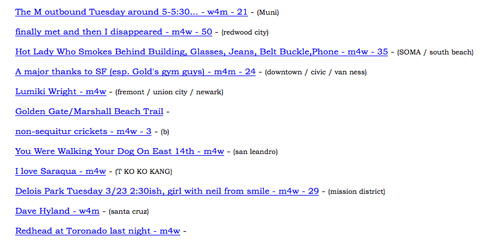
Using her “think tank initiative,” the Center For Missed Connections (CMC), Burrington examines MCs in five cities, charts their trends, and offers a work- booklet so that we might keep a log of our own missed connections as we go about our daily routine. Were someone to stumble upon her findings, one might imagine these graphs and worksheets to be yet another new dating device aimed at an increasingly lonely urban population. Rather, Burrington has created an untraditional piece of work that experiments with and questions our understanding of illusion and reality, blurring the two, while also offering an honest commentary on this phenomenon of communal loneliness and need for human connection in our country. This “outreach initiative” provides a critique of the way in which we communicate, date, relate, and experience loneliness and one another:
“You are in the world, in a city, somewhere crowded and vibrant, full of people. And you are alert with an awareness tempered by the wonderful, unspeakable loneliness of being among strangers… Missed Connections are the embodiment of one of the major lures of cities and urban centers: they are a temporary engagement with a total stranger in uncertain, finite intimacy.”
Burrington takes a humorous look at what constitutes a missed connection, its various forms, and how one may make their post most successful. Various categories of what she deems the “gray area” include, “holla,” “bitches ain’t shit,” and “why doesn’t anyone want to date me.” It’s this superficial cheekiness that cushions the subtext of her work. Rather than beat her audience over the head with the kind of heavy-handedness one might find in some artists’ whose work deals with social commentary; Burrington’s take is comical, relatable, and an astute critique of the way in which our culture often chooses to interact with one another.
Many of Burrington’s projects take things that are mundane- date books, puzzles, and rulers to name a few- and recontextualize them; endowing everyday objects with cultural substance and social critique. Her work is often collaborative, and text appears in nearly every piece. Some take the form of pamphlets and index cards, while others are protest signs or banners that demand “milk & cookies!” or “revolution can be avoided.”
 what do we want? NOW! when do we want it? NOW! . Ingrid Burrington and Matt Bettine 2008.
what do we want? NOW! when do we want it? NOW! . Ingrid Burrington and Matt Bettine 2008.
Her work offers a means of resistance to traditional artistic genres, as well as to our current culture and what is valued. In “Tips for experiencing a missed connection,” Burrington advises her reader how to go about becoming an MC. Among them, the artist suggests you: be attractive; identify which an adjective (cute, hot, sexy, etc) that best suits you and try to embody it; leave before any actual contact can be made; and start living. How very apropos that in trying to really live, we abandon actual interaction and possibility in favor of an online fantasy. It is here, and in other pieces, that Burrington subtly dismantles socially constituted norms and brings them into question.
Burrington manages to avoid heavy handedness as she maps the world of MCs. Rather than create a piece that mocks those who flock to Missed Connections in lieu of real human contact, the artist offers us a thoughtful, rather blithe take on the palpable loneliness that seems to proliferate so many of these posts. Between Match.com, OkCupid, eHarmony, and myriad other dating sites, it’s no surprise that we (the collective we) have become disconnected.
If such sites weren’t to exist, would we still feel the same lack of connectedness? It seems that in attempting to quell the feeling of loneliness and isolation, dating sites may compound the feeling; allowing people to search for others at their leisure and in the comfort of their home. Rather than step out into the world where rejection is a real possibility, those who date online only have to face a virtual one, and can quickly move on to the next profile. CMC is a critical look at this delusional approach to interaction, and acknowledges the irony in our attempts to establish contact via Missed Connections with those we wish to engage in reality, but actively choose not to.
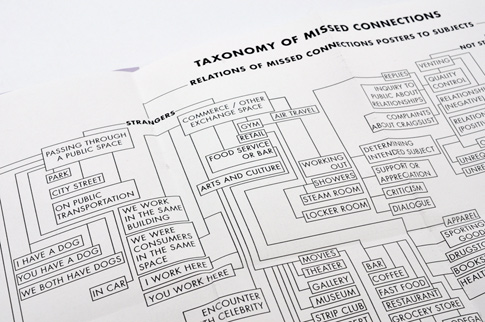 Taxonomy of Missed Connections, detail. In the Center for Missed Connections Citizen’s Field Guide, Center for Missed Connections Information Initiative, 2010
Taxonomy of Missed Connections, detail. In the Center for Missed Connections Citizen’s Field Guide, Center for Missed Connections Information Initiative, 2010
In CMC, we are given statistics, pie charts, and insights into the workings of each city’s MCs. It’s in this urban sea of strangers that we make a connection, and perhaps we find comfort in this collected loneliness. In CMC and other pieces, the artist dares the viewer to ignore this current state of detachment in which we seem to exist. As Burrington navigates the world of interreality through various non-traditional formats, she manages to create works of art that are simultaneously provocative, critical, and humorous; and through them we are given a glimpse at how our culture has dissociated, as well as our genuine desire to find a connection amidst this often self-imposed isolation.
.
.
.
Madeleine Zinn is a writer and erstwhile artist based in Oakland. Her main interests include non-fiction, community arts, pop culture, and queer theory and identity politics. She is currently pursuing a dual MFA/MA in Writing and Visual & Critical Studies at California College of the Arts.
Interview with Ingrid Burrington
Artist Interviews blog CMC TPG13
We interviewed Ingrid Burrington on February 21, 2010.
Introduction to the CMC Information Initiative
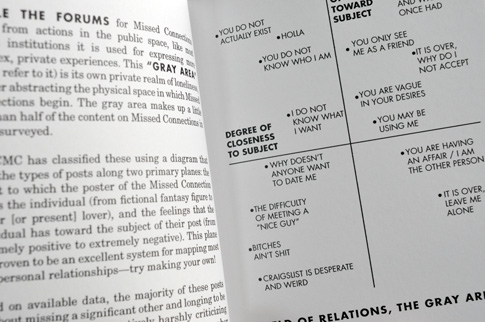
The Center for Missed Connections Information Initiative is an edition of 100 booklet sets by artist Ingrid Burrington analyzing missed connections posts on craigslist.org. It is the most recent project by Burrington’s pseudo-think tank – the CMC – which seeks not only to chart the loneliness of city life but to “encourage people to pay greater attention to those fleeting moments in cities that appear insignificant but linger in memory, producing a richer and more romantic and/or sleazy experience of the urban environment.” The set contains a Citizen’s Field Guide, a Field Observation Workbook, a fold-out “Taxonomy of Missed Connections,” as well as a full-color “Geographic Missed Connections Study: New York”.

The Citizen’s Field Guide attempts to classify Missed Connections posts on a multitude of criterion such as demographic, degree (double take, actual conversation, hookup), reason for connection missed (in a hurry, not wanting to be “that guy”) and location (gym). The fold-out Taxonomy of Missed Connections visualizes much of this research in an easy to digest format. The field guide also presents the results from a short term comparative study of Missed Connection posts from the same 24 hour period in New York, Chicago, Austin, Boston, and San Francisco.
The Field Observation Workbook encourages you to “Be Out and About!” and experience your own missed connections. Put to work as part of the CMC data collectors, participants are afforded a means to take down details about particular missed connections and have a perfect record should they decide to try to engage that special person online.

Ingrid Burrington grew up in Northern California and currently lives in Baltimore, Maryland. She works in text, photography, performance, and print, and has produced projects both as a free agent and under the guise of semi-fictional think tanks, which have appeared throughout the mid-Atlantic and online. She received her BFA from the Maryland Institute College of Art in printmaking.
TPG Expands: Web hosting that Support Artists
artist resources arts funding bay area blog good things internet news
We are on a mission to find more ways to get money into artists hands. Following the funding models that seem to work, models that seem to use what people are paying for anyway, we have decided to start hosing websites. A website has almost become a business card these days. So we wanted to create a platform that would not only help people create their own websites in an affordable way, but give them the opportunity to do something good with the money they would be spending anyway to host their sites.
So host with us! At $84/year, it is comparable to most quality hosting sites out there. Over a quarter of that payment goes directly into The Present Group granting fund. Each granting period, we will choose a theme, accept nominations from within that theme, and allow all the hostees to vote on the winner.
For the first grant, we are teaming up with the Collective Foundation to fund a travel grant for a Bay Area artist. As Renny Pritikin has noted on the SFMOMA blog, the Bay Area sometimes has a hard time holding on to its notable artists. Inspired by the way many other governments work, Joseph del Pesco‘s idea is that part of keeping artists here is to help them with the funds to travel away for opportunities and come back.
Up Next: Matthew Cella
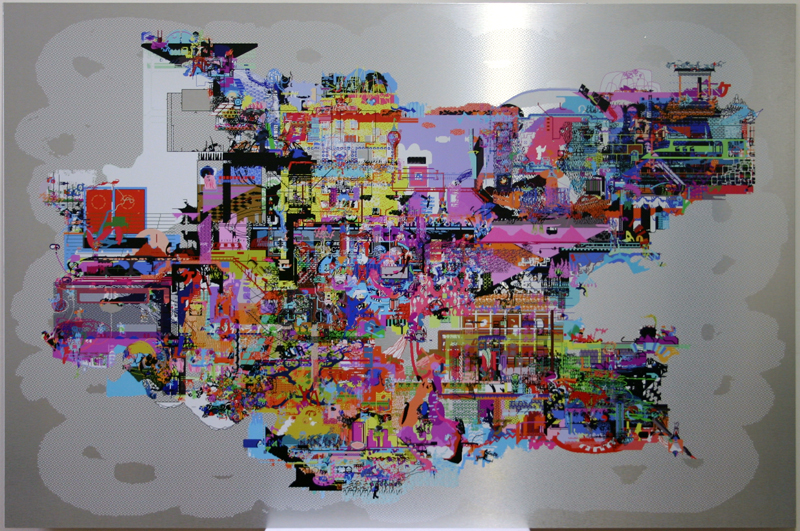 Matthew Cella, “Map 1024,” 48″ x 72″ UV print on brushed aluminum
Matthew Cella, “Map 1024,” 48″ x 72″ UV print on brushed aluminum
Matt Cella fabricates multi-media works that are the product of digitally collaged .;::’til;ps and //??>s. Born in 1981, he received his MFA from the San Francisco Art Institute, and currently lives and works in San Francisco.
LINKS
Archives
Lego Hello World
I wish all my printers were made of legos.
LIFE photo archive hosted by Google
Images from Life Magazine going back to 1860′s, hosted by Google
Coming Face To Face With The President
Well crafted story about an under-heard point of view.
In California, Pot Is Now an Art Patron
A new funding source for the arts – reaping big rewards and funding many projects. It’s pot.
Notes on Portraiture in the Facebook Age
Celebrity Book Club: A List to End All Lists
Because, well, it’s sortof awesome.
Are "Artists' Statements" Really Necessary?
The pros and cons about that nemesis for most artists.
This to That
You tell it what you’ve got and it’ll tell you what to glue them together with.
Work of art: Online store for buyers, sellers
Not the TV show! Kelly Lynn Jones from Little Paper Planes is interviewed on her project, gives us a cheat sheet to local affordable art resources.

